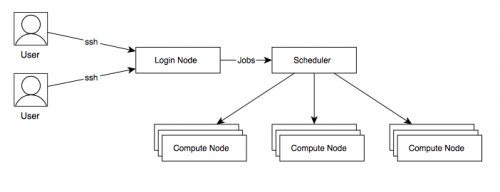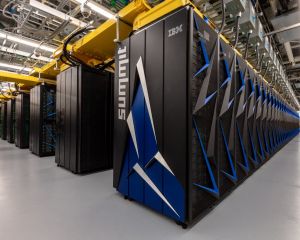Usage of a HPC cluster
- Prev: LabQSM#Getting Started
- Next: Scripting
Here we collect some general (and by no means complete) information about usage and policies of a HPC cluster.
Structure of a HPC cluster
The structure of a HPC system is sketched in the picture above. These are the main logical building blocks:
- a login node is exposed to users for access (typically via
ssh), - a dedicated scheduler (the queuing system) dispatches computational jobs to the compute nodes
- computation happens therefore asynchronously (in batch mode), and not on the login node.
- a specific software environment is provided on the login node and on the compute node to run parallel jobs
- the above cluster structure is used from commodity local machines to large scale HPC architectures (as shown below for the Summit machine at Oak-Ridge Natl Lab (ORNL), TN, USA)
Connecting
Unless other means are provided, you typically connect using the ssh protocol.
From a shell terminal or a suitable app:
ssh -Y <user>@<machine_host_name> or ssh -Y -l <user> <machine_host_name>
<user>: Unix username on the cluster login node <machine_host_name>: hostname (or IP) of the target HPC machine
In order to access you need to have a working Unix username and passwd on the target machine.
Scheduler
Multiple schedulers are available. Examples include PBS Torque, IBM LoadLeveler and SLURM. Here we just cover some examples, providing the main commands to be used within the shell.
PBS Torque
- submitting a job
qsub file.sh
- monitoring a job
qstat # general query, all jobs are shown qstat -u $USER # only my jobs qstat JID
- checking queue properties
qstat -q
- deleting a job
qdel JID
JID (Job ID) is given by qstat
- Interactive use on compute nodes
qsub -I -q <queue_name>
Environment
Use the module command to manage the unix environment
Make sure you load a proper parallel environment (incl MPI-aware compilers)
One example:
module purge module load psxe_2020 # Intel 2020 compiler module load <more modules you are interested in, e.g. incl some QE distribution>
These commands can be also place in the .bashrc file and most of the time need to be present in submission scripts
In order to enquire the module system:
module list # lists loaded modules module avail # lists available modules

